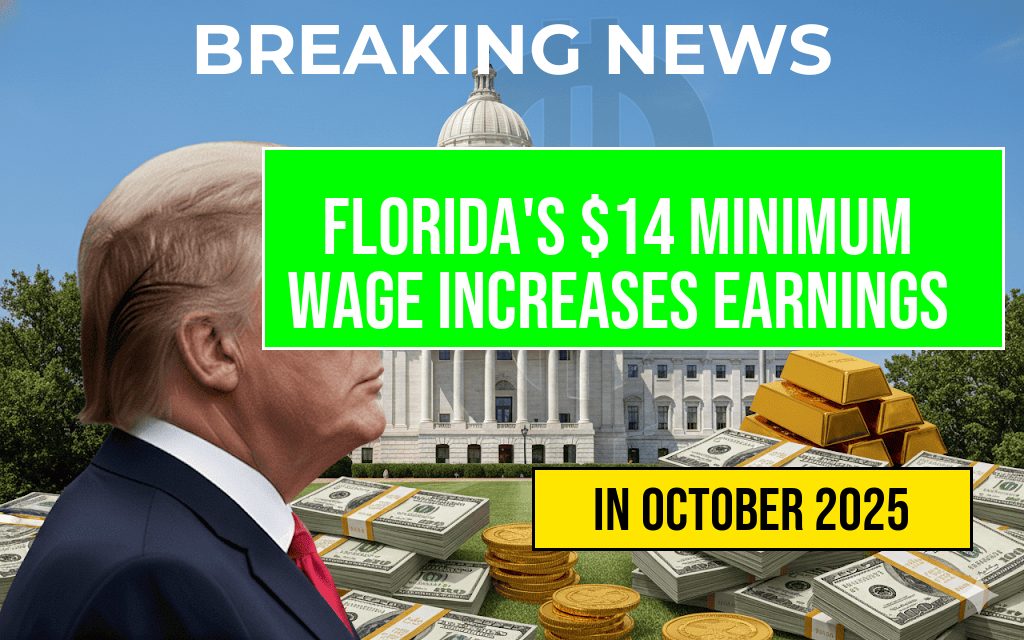Florida’s recent increase in the minimum wage to $14 an hour marks a significant shift in the state’s labor landscape, promising a tangible boost for full-time workers. According to recent analyses, this adjustment is poised to raise the annual earnings of full-time employees by approximately $2,080. The move aligns Florida with a broader trend across several states aiming to address income disparities and improve living standards. As the new rate takes effect, economists and labor advocates note that the increased wages could have ripple effects on local economies, consumer spending, and employment patterns.
Impact of the Wage Increase on Earnings and Cost of Living
Quantifying the Earnings Boost
For full-time workers clocking 40 hours per week, the shift from the previous minimum wage of $11 an hour to $14 represents a substantial increase. Over the course of a year, assuming consistent hours, the additional annual income amounts to roughly $2,080. This figure derives from the difference of $3 per hour multiplied by 40 hours per week and 52 weeks annually:
| Wage Increase per Hour | Hours per Week | Weeks per Year | Total Additional Income |
|---|---|---|---|
| $3 | 40 | 52 | $3 x 40 x 52 = $6,240 |
However, because many workers do not work the full 52 weeks or hours vary, estimates often cite a more conservative figure of approximately $2,080 annually for full-time employees, reflecting typical work patterns.
Addressing Cost of Living Challenges
While the wage increase improves earnings, critics highlight that rising living costs—particularly housing, healthcare, and transportation—may offset some benefits. Florida’s housing market has experienced rapid growth in recent years, with median rent prices climbing steadily, which could limit the real-world financial advantage for some workers. Nonetheless, increased wages can enhance purchasing power and reduce reliance on public assistance programs, according to economic studies.
Economic and Social Implications of the Minimum Wage Hike
Potential Effects on Employment and Business Operations
Business leaders and economists remain divided on the wage hike’s broader impact. Some argue that higher labor costs might lead to reduced hiring or increased automation, especially among small businesses with thin profit margins. Conversely, others note that increased income can stimulate local economies through higher consumer spending, potentially offsetting employment concerns.
- Small businesses may face short-term financial pressure.
- Wider economic activity could benefit from increased disposable income.
- Employment levels might stabilize or grow if consumer demand rises.
Comparison with Other States
Florida’s $14 minimum wage positions it among states with the highest baseline pay rates, following California, Washington, and Massachusetts. The move reflects a broader national momentum towards establishing living wages, with some cities and states implementing even higher minimums. According to data from the Wikipedia entry on minimum wage in the U.S., the federal minimum remains $7.25 per hour, but many states have enacted their own higher standards.
Public Response and Future Outlook
Worker Perspectives
Many full-time employees across Florida welcome the wage increase, viewing it as a step toward economic stability. Workers in sectors such as retail, hospitality, and healthcare report that the higher minimum wage helps cover essential expenses and reduces financial stress. Advocacy groups emphasize that this change is crucial for addressing income inequality and fostering economic mobility.
Policy and Political Context
State policymakers highlight the wage hike as a responsible approach balancing economic growth with workers’ needs. Some officials advocate for further reforms, including proposals to gradually raise the minimum wage to $15 across the next few years. Opponents, however, caution against potential adverse effects on employment and small business viability.
Looking Ahead
As Florida’s minimum wage continues to evolve, stakeholders are closely monitoring its effects on employment figures, business health, and household finances. Research from sources like Forbes suggests that such wage increases can contribute positively to economic resilience if managed carefully. The ongoing debate underscores the complexity of setting wage policies that support both workers and economic vitality.
For more information on wage trends and economic analysis, visit the Forbes business section or the Wikipedia entry on minimum wage economics.
Frequently Asked Questions
What is the new minimum wage in Florida?
The minimum wage in Florida has increased to $14 an hour, reflecting recent legislative updates aimed at improving workers’ earnings.
How does the wage increase impact full-time workers’ annual earnings?
For full-time workers, the increase to $14 an hour boosts their annual earnings by approximately $2,080, providing greater financial stability.
When did the new minimum wage take effect?
The new minimum wage became effective on [insert effective date], marking a significant step in Florida’s efforts to support workers.
Who benefits most from the wage increase?
Full-time workers earning close to the minimum wage are the primary beneficiaries, as they see substantial increases in their yearly income.
Are there any future plans to increase the minimum wage in Florida?
Yes, Florida’s minimum wage is subject to future updates, with plans to regularly review and adjust it to keep pace with the cost of living and economic conditions.

Leave a Reply